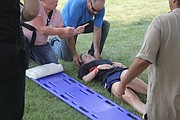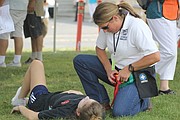Simulated tragedy, real-world takeaways
MOSES LAKE — Just off Bolling Street at the Big Bend Community College campus on Tuesday afternoon there was a mass of commotion. People could be heard screaming in pain for help and first responders were busying themselves loading injured patients onto gurneys. The hustle and bustle was all apart of a wide-scale scenario to see how various agencies and entities from around the area would respond to a potential Mass Casualty Incident (MCI).
The (MCI) was designed to take the form of a bus crash at the BBCC campus. In the scenario, a bus driver suffered a heart attack and crashed his bus into chairs filled with spectators at a soccer match. The exercise honed in on the triage of 29 injured people, including the bus driver and 28 “middle-school-age” soccer players, played by students from BBCC’s Upward Bound and nursing programs and medical simulation mannequins, all of whom had received an array of different injuries.
Tuesday afternoon’s exercise brought together several different agencies and entities, including Samaritan Hospital, Columbia Basin Hospital, Moses Lake Fire Department, several different Grant County Fire Districts, Grant County Sheriff’s Office, MACC Dispatch, Moses Lake Police Department, Washington State Patrol, emergency medical services, Region 7 Health Coalition, North Central Educational Services District, Wenatchee Valley College, Moses Lake School District, BBCC, LifeFlight Helicopter and the Grant County Coroner's Office.
“It takes a lot of agencies and a lot of different resources working together to respond effectively to an accident such as this, or any type of situation where a lot of people are injured or in danger,” BBCC Director of Communications Matt Killebrew said. “You cannot just sit back and hope it does not happen; you have to prepare for it. Training such as this allows us to become familiar with first responders and facilitates communication between all of us. We want to thank them all for working with us to keep us better prepared.”
BBCC and the MLSD used the exercise to fine-tune practical management via several different methods of communication. The involved entities will also be assessing their role in the exercise and how they performed to better prepare for a future MCI.
MLFD medical services officer Todd Schanze noted Grant County is not exempt from an MCI occurring. In fact, as Schanze pointed out, the area has seen a large plane crash in the past, chemical releases in the 1980s and 1990s resulting in fatalities and the 1996 mass casualty shooting at Frontier Middle School in 1996, which left two students and a teacher dead.
“Training, getting to know our community partners, and exercising those partnerships before an event will help us navigate a real disaster. Managing 20-30 people is a realistic expectation. We hope to start the conversation between all the agencies that we need to train with in order to optimize our resources and make our community both safer and prepared for the unexpected,” Schanze stated. “(The MCI) was an eye-popping event that we hope everyone comes away from with a better understanding of where we currently are, and where we need to be in regard to preparedness.”





